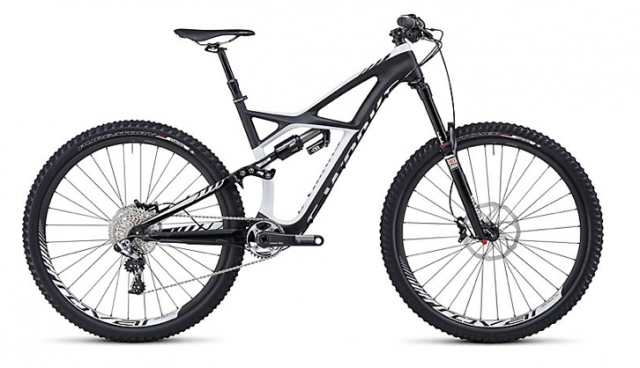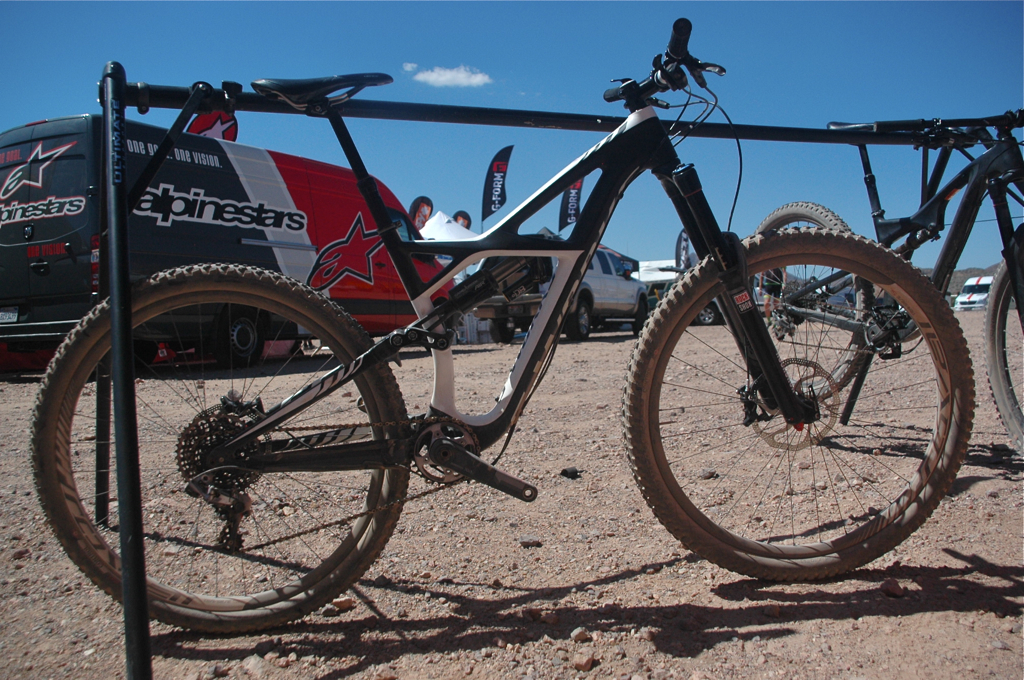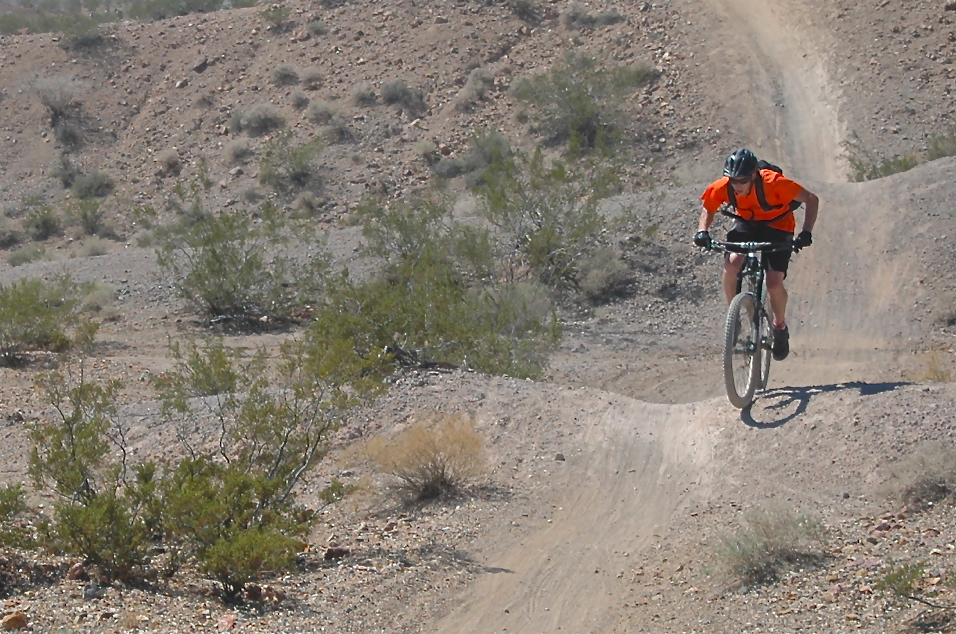
2014 Specialized Enduro Carbon 29
Wheels: 29″
Travel: 155mm
Geometry: Click here
Rider Info: 5’9”, 150 lbs.
The Build
- Custom Cane Creek Double Barrel air shock
- RockShox Pike RCT3 fork
- SRAM XX1 11-speed drivetrain
- Roval Traverse SL 29 142+ wheelset
MSRP: $9,250
Days Tested: 1
Locations Tested: Bootleg Canyon, Boulder City, Nevada
The Caveat
Last week, we tested bikes on the rocky trails around Boulder City, Nevada during the Interbike Outdoor Demo. We’ll keep rolling out First Looks of the other bikes we rode (including the Yeti SB95 and the GT Fury), so stay tuned. But before we get to our initial impressions of the Enduro 29, an important caveat:
(And if you’ve already read the intro to the review of the Pivot Mach 6 or the Santa Cruz Bronson, feel free to skip this part and scroll down to First Impressions.)
Riding bikes at a demo is always kind of tricky. For starters, we didn’t get a lot of time on each bike—at most around an hour, and with many bikes it was just a 25-minute loop. 25 minutes can tell you a lot about how a bike handles, but it certainly doesn’t allow for our customary in-depth, BLISTER analysis.
In addition, these bikes are set up by mechanics at each company’s booth, and while these guys do a great job, there isn’t really time to get each bike dialed for how I’d normally set it up. (If nothing else, I probably would have put wider bars on most of the bikes I rode.)
And then there are the trails. Interbike’s Outdoor Demo takes place at Bootleg Canyon in Boulder City. It’s a little bastion of awesomeness that overlooks the pit of despair that is Las Vegas, and the trails are fantastic: super rocky, with lots of sand, some rocks, some jumps here and there, and did I mention the rocks? Most of my time on these bikes was spent on the more cross-country oriented trails, even though the DH trail system is (in my opinion) the crown jewel of the Bootleg trail network.
The XC trails have a good mix of flowy corners, short punchy climbs, rock gardens, and a bit of chunder. All in all, they’re decent for testing out the different aspects of a given bike, but to really develop a feel for how a bike works, there’s no substitute for riding it for a long time on a lot of different types of trails.
So with all that in mind, let’s talk about the Enduro 29.

First Impressions
I own the 26″ wheeled version of the Enduro (the 2013 “Expert” model, which I reviewed here), so it was with some interest that I climbed aboard the Enduro 29 at the Interbike demo. Is it faster? Is it better? Do I need to sell off my 26er and put in an order for the wagon wheeler?
The Build
The Enduro 29 that I rode was the top of the line S-Works version, meaning that it has fancier carbon fiber in the front, and and comes kitted out with top of the line components. It comes with the new Cane Creek Double Barrel Air rear shock that has all of the adjustability that we’ve come to know and love from Cane Creek, with the addition of a climb switch to dramatically firm things up for climbing.
While I haven’t spent a ton of time on the Double Barrel Air, I’ve put in a lot of time on a coil Double Barrel. It pretty much sets the standard for user-tunable suspension; it’s a fantastic shock. That said, it takes some time and patience to get the shock dialed. The Double Barrel (both coil and air versions) have high and low speed compression adjustments as well as high and low speed rebound. Each adjustment has a pretty huge range, so dialing in each setting takes a while.
The upside of this is that, eventually, it’s possible to get the suspension to feel awesome. The downside is that for a relatively short test at the Interbike demo, I definitely didn’t have time to get the rear shock dialed.
The shock on my test bike felt firm, and it was a bit harsh over small and medium size hits. While this made the test ride less awesome, I’m also very confident that this isn’t the fault of the frame or the FSR design. Without a doubt, if I had been able to tinker around with the suspension setting, I would have been able to get the rear end feeling much better.
Aside from issues with the suspension settings, the rear end felt much like my smaller wheeled Enduro. It climbs okay; there’s definitely some suspension movement while pedaling. The climb switch on the Double Barrel does a good job of taking care of this issue, but the switch was a little tough to get at on the medium frame that I rode. Not the end of the world, but somewhat annoying considering that I use the climb switch on my Enduro fairly often.
For front suspending duties, Specialized spec’d the Enduro 29 with the new Rockshox Pike, which is a great piece of equipment. I didn’t have time to put the Pike through its paces during my short test, but it felt buttery smooth, stayed high in its travel, and resisted diving.

NEXT PAGE: On the Trail

Quote: We at Blister are generally in agreement that Strava is stupid.
If you listen carefully, even though I’m nearly a thousand miles away from you in Hood River, you can hear me and many others clapping loudly after reading this statement!
Nice review. I’ve always been a bit of a boutique brand bike snob, but after riding a Trek Remedy 29er, I bought one. Smiles are large and continuous. Last thing I expected from boring old Trek!
So the Enduro 29 with 16.9″ stays (the shortest for any 29er with this travel) doesn’t like to turn? Are you sure you were on the right bike? Most reviews I’ve seen have said the opposite.
Hey Bob,
Yup, you read it correctly; I’m saying the Enduro 29 doesn’t like to turn. You’re right – the Enduros (both the 26 and 29 versions) have short stays, but that doesn’t tell the whole story. The Enduro 29 is a long bike (16.7″ reach, 45.6″ wheelbase) with a slack headtube (67.5 degrees; slack for a 29er) and big wheels. All of that adds up to straight line stability, not tight, whippy flickability. The short chainstays certainly make it more turny, but that’s one attribute that errs towards maneuverability up against a whole slew of attributes that lean towards going straight.
To look at it another way, in my review of my Enduro Expert (26″ wheels) I said that it was much more happy going straight and fast than working through tight terrain – a sentiment that is generally agreed upon by most people I’ve talked to about that bike. The Enduro 29 takes a similar frame, lengthens the chainstays, lengthens the wheelbase, and adds larger diameter wheels. It shouldn’t really be any surprise that the Enduro 29 has all of the same attributes of the 26 (straight line stability at the price of maneuverability), but even moreso.
And yeah, there may well be other reviews that call the Enduro 29 maneuverable (most of the ones I’ve read have at least noted that it was a handful in tight places, but I haven’t read all of them). I disagree with any review that says that the Enduro 29 will go through tight stuff easily or similarly to a 26er. But that’s not to say others won’t feel differently – your mileage may vary.
Interesting reviews. I am split between this and the pivot mach 6, coming from 2 longish travel 29ers I know the benefits and the enduro seems to answer allot of the problems I had with those bikes. I just wanted to ask how the 2 compare as I have had very limited demo time on the enduro and a little more on the pivot but nothing like enough. As someone who has ridden both what’s your view?
Hey Ben,
Well, they’re both sweet bikes and I don’t think you’ll go wrong either way. In a lot of ways they’re pretty similar; they’re both happiest at higher speeds, and they’re both a bit unwieldy in slower, tighter spots.
The Mach 6 wins in the pedaling efficiency department, and once it’s up to speed, I would say that it feels a little more maneuverable.
The big wheels on the Enduro 29 definitely roll over rocks and roots better, and for that reason, it does a better job at holding its speed. The bigger wheels do come with the normal drawbacks though – a bit heavier, slower to accelerate, and less inclined to change direction (which can be a good thing or a bad thing, depending on the situation). All other things being equal, the bigger wheels also tend to be a bit flexier.
If I were recommending one or the other, I’d first look at the trails you’re normally riding; are they tight and technical? Fast and flowy? Lots of jumps and drops? Fire road climbs, or techy singletrack climbs? A little bit of everything?
If your trails are tighter and slower, I’d lean slightly towards the Mach 6 – it just feels a little smaller, and it seemed easier to carry speed through tight spots. I’d also lean towards the Mach 6 if you’re doing more techy singletrack climbs – the dw link pedals better and does a better job of staying efficient during quick bursts of power while remaining active to help you over roots and rocks. If your trails are at the fast end of the spectrum, I’d go with the Enduro 29. And if you spend a lot of time climbing fire roads or smoother climbs, the pedaling efficiency is less of a big deal because you can just lock out the shock.
Second, I’d look at your riding style. Do you break the back tire and loose and square off corners? Do you roll through things as smoothly as possible and try to retain speed? Are you more inclined to stay low and fast, or do you pop off of every trail feature and huck to flat? Are you looking for a DH bike that can pedal, or are you looking for a trail bike that can hang in the rough stuff?
If you’re looking more for a long legged trail bike that can motor through technical bits, the Enduro is what you want. If you’re looking for something that rides more like a scaled down DH bike, I’d swing towards the Mach 6. The Mach 6 handles tight terrain a little better just because it’s a little more flickable and ridden in a “drifty” style where you’re breaking the tires loose fairly often. The Enduro can do that as well, but it seemed happier to stay hooked up and roll through things smoothly. I’d also lean towards the Mach 6 if you’re leaving the ground often. Not to say that the Enduro is unhappy in the air, but the Mach 6 feels totally at home hitting jumps and drops.
Hopefully this helps. Also, keep in mind that I’m kind of splitting hairs here. While the two bikes are definitely different, they end up achieving a similar goal – they just get there differently. They’re both stable bikes that like to go fast. The Mach 6 gets there more via its geometry, while the Enduro gets there more with the wheel size.
Hi Noah, I’m blown away by your response I really am, thanks for taking the time. You have mainly confirmed what I thought the characteristics of both would be and its great to get that insight.
I am at home on 29ers and am leaning in that direction given what I ride, so will try and get a bit more time on the Enduro and check what its like in the air and in tight sections before making a decision. Thanks again and will keep an eye for your future reviews they read well.
Hi Noah. Great review . it is very helpful. You guys are awesome.
Quick question, – I’m doing cross country racing mostly riding scott scale 29 and other 29 ers hardtail for training and a specialized camber 29,
i loveeeee 29 ers maybe because i’m big guy 6 feet 3 , 85 kg like how they roll over stuff grip speed etc.
i recently started racing Enduro .. like classic style like “enduro world series”
looking for a long travel enduro machine – but must be a 29er because plan to ride it daily for fun and training
the only long travel tick “stiff” fork bike i am looking at is Specialized enduro 29 ?
do you think it will do the job? as a enduro racing bike but be able to climb and trail ride it too .
i did raced with my Camber 29 but with only 100 mm travel .. is no good
because my bikes are all 29 and all of them XL frame i am used to “school bus” cornering
just want to be able to ride it up .. pedal .. and bombard down on very rough and tough enduro race ones in a while, or maybe other bikes in mind?
Thanks a lot
Hey Emil,
It sounds to me like the Enduro 29 will be right up your alley. If you like the Camber but you want something that will do a bit better at higher speeds on rougher terrain, the Enduro 29 is exactly what you’re looking for, especially if you’re already used to the handling characteristics that come with full suspension 29ers.
If you’re only looking at 29ers, the Enduro 29 is definitely high on the list of the bikes I’d recommend. Of the longer travel 29ers I’ve ridden (which is far from all of them), the Enduro takes the cake for confidence inspiring stability. A non-exclusive list of some others that are worth looking at (in no particular order): Trek Remedy 29, Kona Satori, Banshee Prime. Yeti SB95, Santa Cruz Tallboy, Niner WFO. I’m sure there are plenty of bikes that I didn’t mention that I should have – those are just the ones that immediately come to mind.
Out of those, I’ve only gone on a real ride on the Satori and Yeti (both of which I’ve written about on here). The Niner WFO is probably the one that seems most similar to the Enduro in terms of the intent of the bike (meaning it’s longer travel, pretty slack, clearly intended for high speed destruction).
Hope that helps!
At 5’9 is the medium or large frame the best fit ?
At 5’9″, I’d go medium unless you have a strong preference for really big bikes.
On the Enduro at 5’11” I’d say Medium. It still has a long reach right between a M and L on the SJ Evo 29. Unless you were convinced the M was too small…
In the SJ Evo 29 I’d say L without hesitation but the Enduro is different. The effective seat angle is very steep like a Kona Process or any newer Rocky Mountain (like 75 degreee) so you will end up with a shorter measured top tube. Your reach number is still pretty long on the Medium. Run a set back post or your seat back on the rails a bit.
I currently ride a 26 inch Trek Remedy 8. Although I really like the bike, Im sold on the stability and confidence that the 29 inch wheels inspire. Im currently considering an 29 inch Enduro Comp. Took one for a little ride the other day. I did like the bike, but found the medium to cramped. I am just shy of 5-11. Would you say that a large would be too big for me? Additionally, I do a fair bit of road riding to get to the trails and I also to a lot of hills on roads for cardio and strength training. I want the bike to be at least as efficient for grinding up hills as my current bike?
Hey Ted,
At around 5′ 11″, I would guess that you’ll be more comfortable on the large (especially since you found the medium to be cramped). As far as efficiency, I’ve found the Trek design to be marginally more efficient pedaling than the Specialized, but that’s 1) splitting hairs, and 2) really more dependent on the shock setup. The Enduro Comp 29 comes with a Fox CTD Evolution rear shock – when put into “climb” mode, it will pedal very efficiently and it’ll still do pretty well in “trail” mode too.
Hi Noah, great review.
I have the Enduro expert 29 2013 with a 150mm fork, but now the new models of the Enduro come with a 160mm. I was thinking of changing my fork to a 160mm Pike. But I really don’t know if the geometry of my bike (2013) is different with the new 2014 model.
What do you think?
Noah-
The sworks main frame is the same modulus carbon as the expert version…
Yes, the chain stays of the 26er are 11mm shorter, no the 29er’s stays can ever be considered long, nor should this bike ever be considered solely a point and shoot bike.
Your riding ability may need to be brought into discussion before these assumptions can be made.
Thanks,
Jack – a proud enduro 29er owner
Yes that thing can corner
Heh. Noted. I’ll look into some skills clinics.